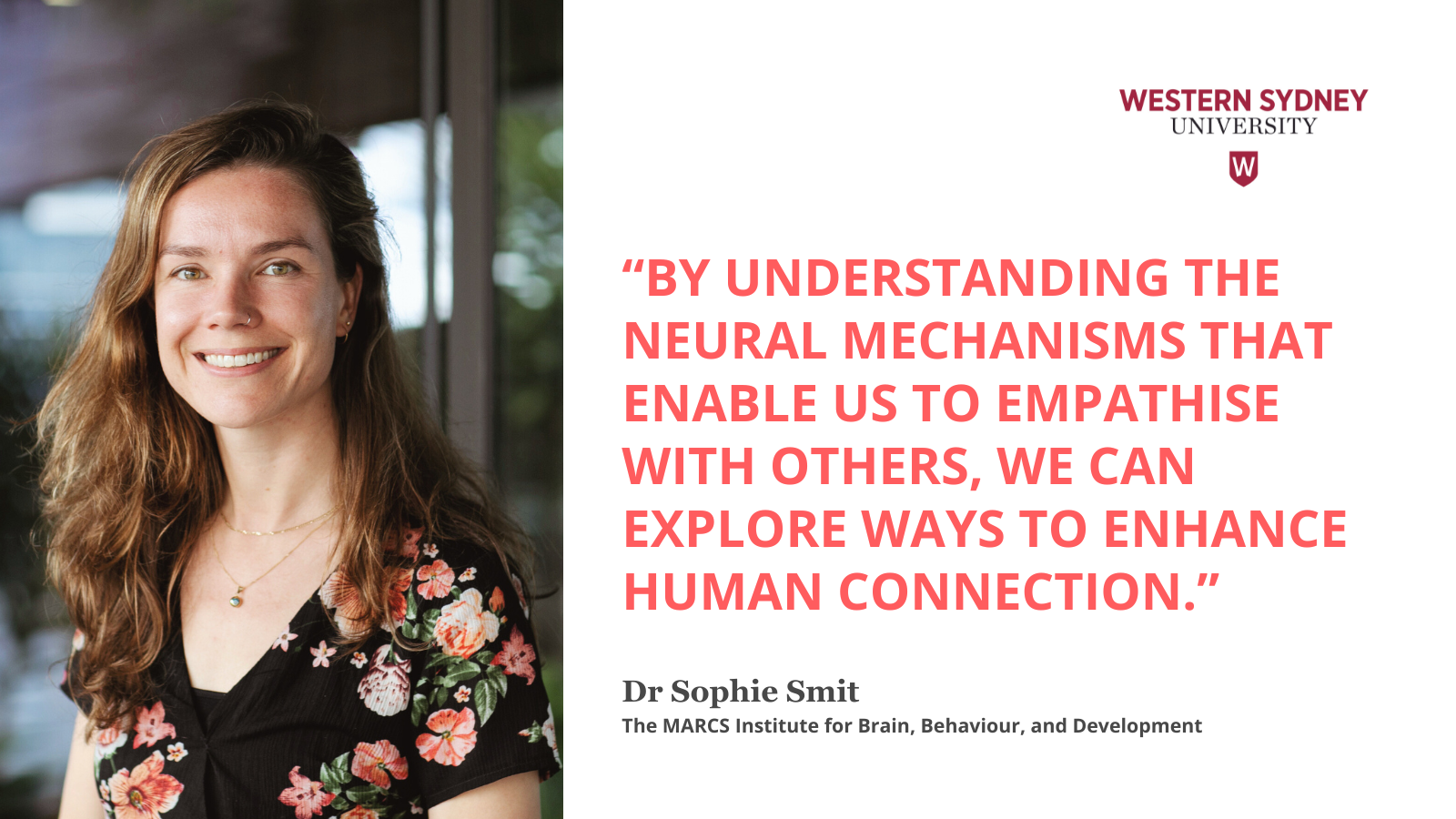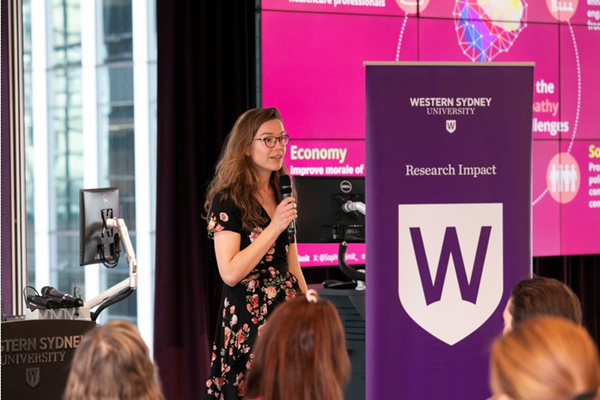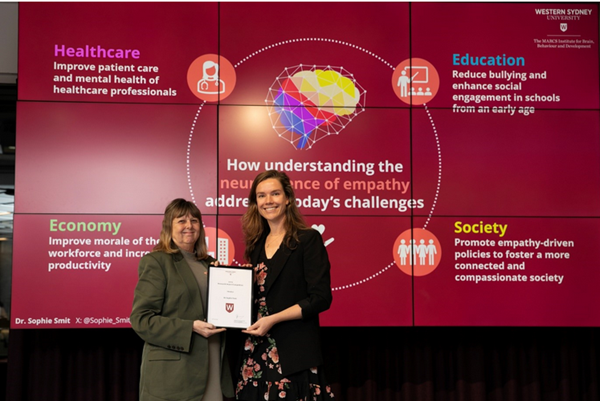What’s Your Research Story – Sophie Smit

In “What’s Your Research Story”, we delve into the diverse talents and achievements within MARCS Institute, celebrating milestones and innovation.
Join us as we learn more about the research journey of Dr Sophie Smit, Postdoctoral Research Fellow in Cognitive Neuroscience.
Sophie’s research investigates how the brain processes information from the world around us, focusing on the integration of visual and tactile information, which is crucial for aspects like self-perception and social understanding.
This year, Sophie represented the MARCS Institute at the Western Sydney University Research Impact Competition 2024. Her presentation, 'How Understanding the Neuroscience of Empathy Addresses Today’s Challenges', captivated the audience and earned her the People’s Choice award.
What inspired you to pursue research in neuroscience, and how has your journey evolved since you began?
My journey into neuroscience was sparked when, at around 12 years old, I read Sophie's World by Jostein Gaarder. The book follows a 14-year-old girl, also named Sophie, as she explores the history of philosophy and grapples with profound questions about reality and existence. I was fascinated by the idea that our understanding and perception of the world are shaped by our thoughts, beliefs, and experiences—not just the ‘real world’ out there. After reading it, I declared to my parents that I wanted to be a philosophy professor when I grew up. This fascination with how the mind works and why people experience the world so differently stayed with me.
I went on to study both Cultural Studies and Philosophy during my undergraduate years in Amsterdam. A semester abroad in Sydney sparked a love for the city, to which I eventually returned. But first, I moved to London to pursue a Master’s in Philosophy. I devoured books on the mind and consciousness but found myself craving a more scientific approach to understanding these topics. This led me back to Sydney, where I enrolled in an MRes and later a PhD in Cognitive Science at Macquarie University.
During one of my coursework units, I was introduced to the rubber hand illusion, an experiment where a person watches a fake hand being stroked while simultaneously feeling strokes on their own hidden hand. When the strokes on both the fake and real hands are synchronised, many people begin to feel as if the rubber hand is part of their own body. I found it fascinating that our perception of our own body—something so central to our existence and daily functioning—could be so easily altered! But not everyone experiences this illusion in the same way. Some people have a very fixed sense of self, while others have a more flexible perception and even struggle to distinguish their own experiences from those of others. This inspired me to dive deeper into how people perceive themselves and others, especially in terms of body awareness and sensory experiences.
What do you find most interesting or exciting about your current research?
In my research, I explore how individuals perceive the world differently, with a particular focus on their sensory experiences—both their own and those they vicariously experience when observing others. I use a combination of subjective assessments—where participants might answer questions like, “Do you feel tactile sensations in your body when you see others being touched or in pain?”—alongside objective brain data collected via EEG. This approach enables me to uncover how people mentally represent these sensory experiences and how these representations shape their ability to empathise with others. For example, some individuals exhibit brain activity when observing someone else being touched that mirrors the activity that occurs when they themselves are touched. This indicates they may be mentally simulating the sensations as if they are experiencing them firsthand. Intriguingly, this similarity between seeing and feeling touch tends to occur only in those who report experiencing vicarious sensations when observing others. When we rely solely on people’s subjective reports of their experiences, it’s often hard to gauge exactly what they mean. By linking these self-reports to measurable neural differences, we can get a clearer, more direct understanding of how these experiences manifest in the brain.
What excites me most is how we can apply these insights. On one hand, understanding individual differences in perception can foster greater empathy. It reminds us that we all experience the world in unique ways, shaped by our biology, upbringing, and cultural context, and that we should approach others with compassion. In addition, by understanding the neural mechanisms that enable us to empathise with others, we can explore ways to enhance human connection. This merges my core interests: investigating the uniqueness of the mind, the influence of culture and context on perception, and promoting mindfulness and compassion by appreciating both the uniqueness and shared aspects of human experience.
What motivated you to participate in the University’s Research Impact Competition, and how did it influence the way you present and think about your research?
Participating in the University’s Research Impact Competition was a great opportunity for me to practise explaining my research to a broader audience. As researchers, we can often get so immersed in the intricacies of our work that it becomes easy to forget how to communicate these ideas in a clear and accessible way. Learning to distil complex topics, like individual differences in perception and the neural underpinnings of empathy, is not only a valuable skill but also a meaningful way to share insights that can have practical applications.
For example, my research on how people vary in their capacity to empathise has the potential to reshape our understanding of empathy across different contexts and how it can be nurtured. It’s exciting to consider how personalised empathy training, tailored to each individual’s unique way of relating to others, could help address real-world challenges—whether by reducing burnout and improving patient care in healthcare settings, or by tackling bullying in schools. The competition reminded me of the value in sharing research with a broader audience—not only to promote scientific understanding but also to contribute to solutions for pressing societal issues.
How can understanding the neuroscience of empathy benefit society? Imagine implementing empathy-based training programs to reduce bullying in schools or help healthcare professionals manage burnout by building emotional resilience.
Sophie’s research explores how the brain processes different aspects of empathy, including for emotions and physical sensations like touch and pain. Her findings will help develop tailored empathy training programs that can be applied to various sectors, fostering a more compassionate and connected society.





